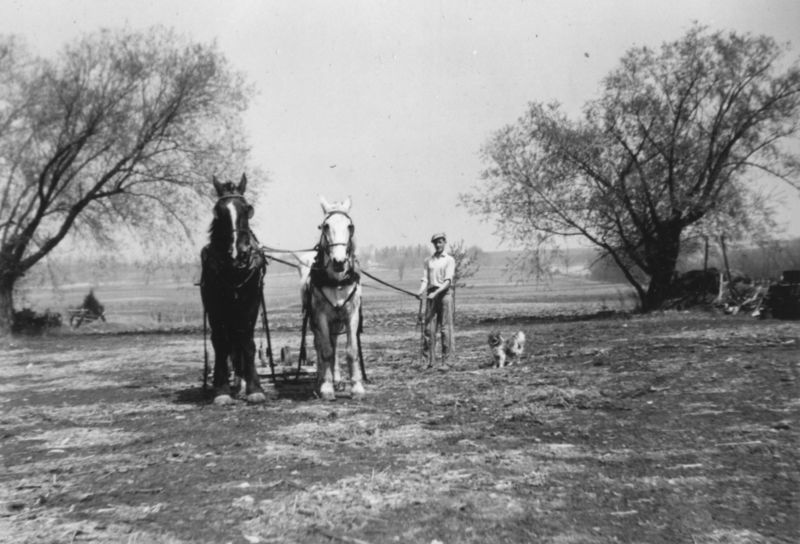 This photo was titled, “Bob, Flipo, and Elmer.” However, we’ve got four entities in the photo: Two horses, a man, and a dog. So, who’s who? Elsewhere in the album, we’ve met an “Elm“, which is probably short for Elmer, and a Brownie, that looks a bit like this dog. So, that means the horses are named “Bob” and “Flipo.” What are Bob and Flipo doing? It looks like they’re hitched to a drag of some sort, scraping the surface of the ground to turn the turf under and either prepare it for planting, or just turn the weeds under so they don’t become too unmanageable.
This photo was titled, “Bob, Flipo, and Elmer.” However, we’ve got four entities in the photo: Two horses, a man, and a dog. So, who’s who? Elsewhere in the album, we’ve met an “Elm“, which is probably short for Elmer, and a Brownie, that looks a bit like this dog. So, that means the horses are named “Bob” and “Flipo.” What are Bob and Flipo doing? It looks like they’re hitched to a drag of some sort, scraping the surface of the ground to turn the turf under and either prepare it for planting, or just turn the weeds under so they don’t become too unmanageable.
Tag: 1938
Howie and his Truck
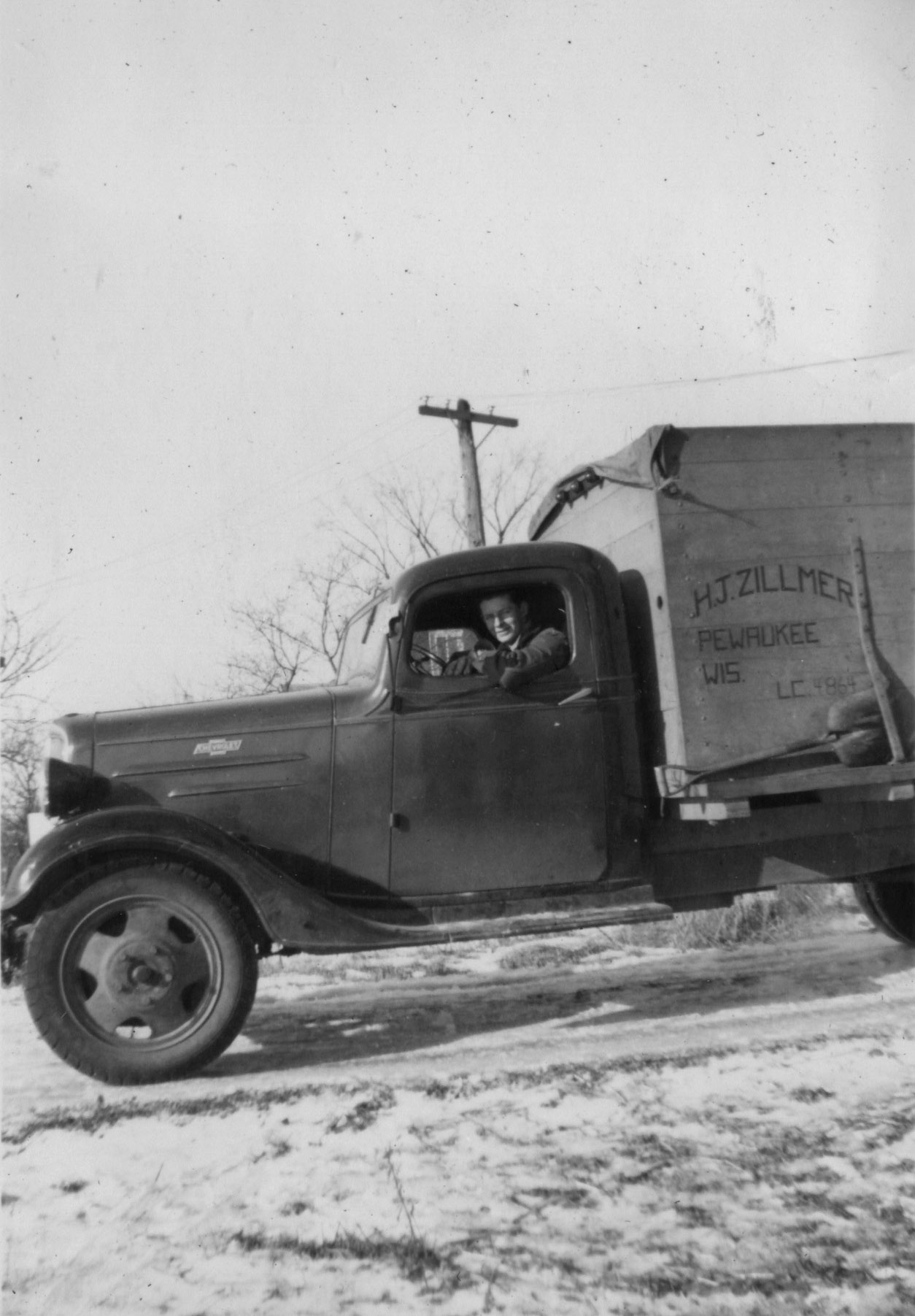 This picture was captioned “Howie.” Mr. Zillmer had a truck, was from Pewaukee, Wisconsin, owned a 1930s-era Chevrolet truck, and was friends with the photographer of this album. That’s about all we know — and with this magic of the internet, can anything more be discovered? Not as much as you might think — Howie could certainly be “Howard Zillmer” — the internet brings us a flyer from a church in Florida that lists Zillmer’s birthday as January third — Florida’s quite a ways away from Wisconsin, though. 2003 brought us the obituary of a Howard Zillmer’s mother, Augusta, who had been born in 1910 and lived in Pewaukee. Howard E Zillmer enlisted in the military in Milwaukee shortly after World War II broke out, but — also in Milwaukee — Howard R Zillmer held out until ’43. Our photogenic Howard, however, looks older than any of the possible Howards on the internet. If internet archives have slowly reached back to the ’40s, maybe eventually we’ll be able to find Howie. Until then, he’s remembered for driving his grain truck past Ruth.
This picture was captioned “Howie.” Mr. Zillmer had a truck, was from Pewaukee, Wisconsin, owned a 1930s-era Chevrolet truck, and was friends with the photographer of this album. That’s about all we know — and with this magic of the internet, can anything more be discovered? Not as much as you might think — Howie could certainly be “Howard Zillmer” — the internet brings us a flyer from a church in Florida that lists Zillmer’s birthday as January third — Florida’s quite a ways away from Wisconsin, though. 2003 brought us the obituary of a Howard Zillmer’s mother, Augusta, who had been born in 1910 and lived in Pewaukee. Howard E Zillmer enlisted in the military in Milwaukee shortly after World War II broke out, but — also in Milwaukee — Howard R Zillmer held out until ’43. Our photogenic Howard, however, looks older than any of the possible Howards on the internet. If internet archives have slowly reached back to the ’40s, maybe eventually we’ll be able to find Howie. Until then, he’s remembered for driving his grain truck past Ruth.
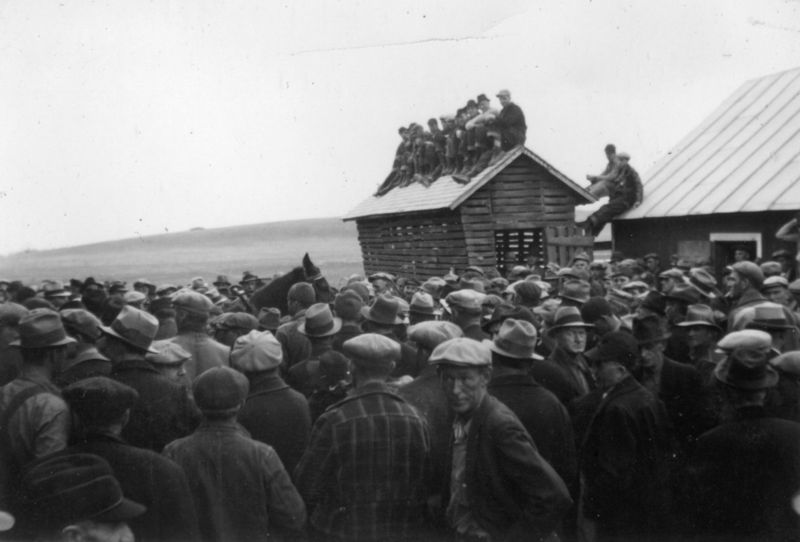 This image, one of two captioned “At Uncle Nick’s Auction,” shows a common sight around the rural USA during the 1930s. No, not just a crowd of fedoras and paperboy hats (although those were quite common, especially at the employment office or the bread lines). Farm foreclosures were driven by the Great Depression, a sluggish economy, a prewar slump due to foreign instability, and the ongoing change from a raw-materials economy to a manufacturing economy. This one appears to have been taken in 1938, after the “heyday” of foreclosures in the early 1930s. Early on, farmers protested and caused ‘penny auctions’ — friends and neighbors ran off genuine bidders, and never bid more than a penny for any lot. By the late 1930s the worst of it was over, some economic reforms were starting to help, and this auction was probably handled better than frantic bank-recoveries earlier in the decade.
This image, one of two captioned “At Uncle Nick’s Auction,” shows a common sight around the rural USA during the 1930s. No, not just a crowd of fedoras and paperboy hats (although those were quite common, especially at the employment office or the bread lines). Farm foreclosures were driven by the Great Depression, a sluggish economy, a prewar slump due to foreign instability, and the ongoing change from a raw-materials economy to a manufacturing economy. This one appears to have been taken in 1938, after the “heyday” of foreclosures in the early 1930s. Early on, farmers protested and caused ‘penny auctions’ — friends and neighbors ran off genuine bidders, and never bid more than a penny for any lot. By the late 1930s the worst of it was over, some economic reforms were starting to help, and this auction was probably handled better than frantic bank-recoveries earlier in the decade.
Also: farmer’s diary * iowa depression * nebraska foreclosures * remembering farm life
Claiming Her Own Nickname
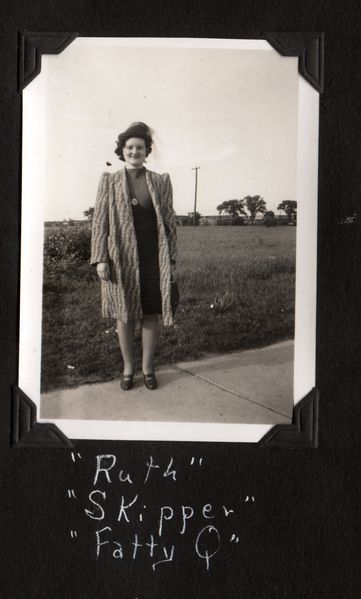 Here, to the right, is Ruth. She once had a photo album of her life in the late 1930s, which I’ve started scanning recently. On the second page of the album, she has a series of captioned photos captioned as a dramatis personae, identifying the players in her life. Her self-portrait includes several nicknames — “Fatty Q” being one of them. While not the lithest of ingenues, Ruth isn’t obese, so that might be why she’s accepted the nickname without offense. The nickname of ‘Skipper’ is interesting, too. The two things we associate ‘skipper’ with — the fat guy on Gilligan’s Island, and Barbie’s sister — were decades away from Ruth’s life. Captaining a boat was the main definition, although ‘one who skips’ could mean she either has a slight jump in her step, or maybe she prefers to avoid going to class. Either way, Ruth has two 1930s nicknames that she was proud enough to own to save it for her kids to see: I hope she was still as proud of them years later.
Here, to the right, is Ruth. She once had a photo album of her life in the late 1930s, which I’ve started scanning recently. On the second page of the album, she has a series of captioned photos captioned as a dramatis personae, identifying the players in her life. Her self-portrait includes several nicknames — “Fatty Q” being one of them. While not the lithest of ingenues, Ruth isn’t obese, so that might be why she’s accepted the nickname without offense. The nickname of ‘Skipper’ is interesting, too. The two things we associate ‘skipper’ with — the fat guy on Gilligan’s Island, and Barbie’s sister — were decades away from Ruth’s life. Captaining a boat was the main definition, although ‘one who skips’ could mean she either has a slight jump in her step, or maybe she prefers to avoid going to class. Either way, Ruth has two 1930s nicknames that she was proud enough to own to save it for her kids to see: I hope she was still as proud of them years later.
Laziness and the P.W.A.
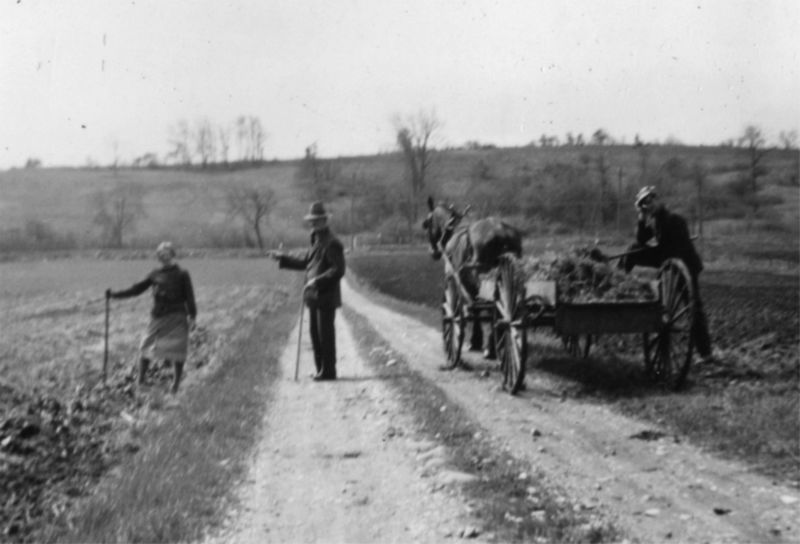
In 1933, the US government starting putting a large amount of money into public works, helping the economy, building communities, and keeping people working. The PWA, or Public Works Administration, did a lot of high-profile work, but the PWA helped communities and projects of all sizes. This picture was captioned “P.W.A. Workers” — however, they look hardly like a PWA project. The owner of the photo album had a sense of humor; the PWA (and its relative, the WPA) had a somewhat undeserved reputation for laziness. Ms. Photographer, it seems, saw a woman in the field — and the guys not working — as representative of the PWA, whether or not their paychecks came from the New Deal or not.
see also: the pwa *pwa thoughts * *pwa and nat’l parks * the wpa * wpa murals * wpa in georgia * wpa posters
1930s Nicknames
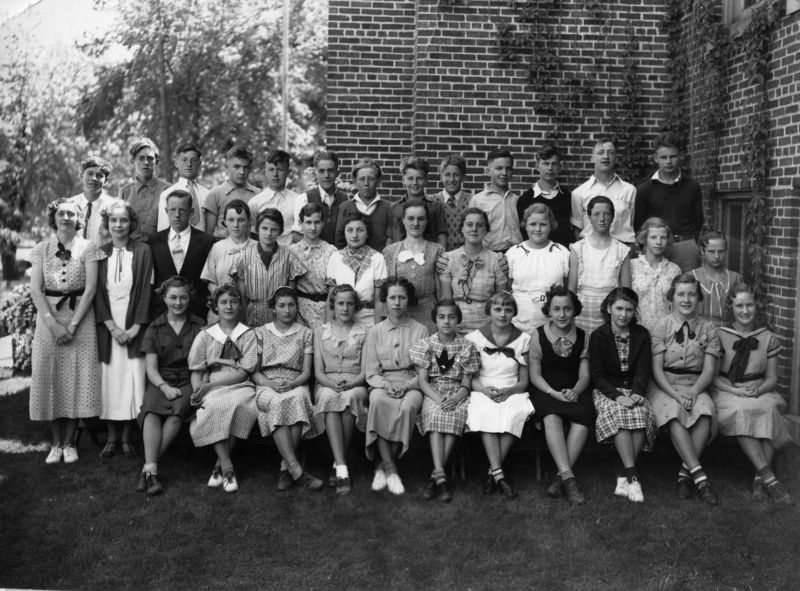
High school — a time of nicknames and rivalries no matter when you were born. This photo, from a photo-album of the late 1930s, has some evidence on the front. That girl in the front row in white — right in the middle — has her eyes blacked-out with pencil (you can see it in the large version). On the back were, presumably, well-wishes from student’s friends, names written in the hand of the signer. Underneath the photo, written on the page in the photo album, are a clearer picture of the students identities: “Bruno”, “Giggling Gertie”, “Ossie” — and I think that’s just the girls.